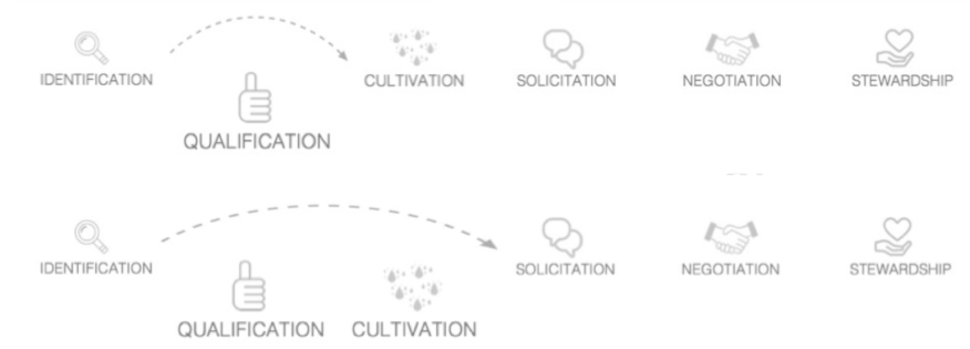We use cookies to ensure that we give you the best experience on our website. By continuing to use this site, you agree to our use of cookies in accordance with our Privacy Policy.
 Login
Login
Your Role
Challenges You Face
results
Learn
Resources
Company
Is donor qualification more important than donor identification?



Identification.
If you are a major or legacy gift fundraiser, you’re probably responsible for a group of donors on your caseload or portfolio. The collection might have been prepared after a review of some transactional data including a donor’s recency of giving, their frequency of giving, and the total monetary value of their gifts (also known as RFM). You might have a team behind you that conducts prospect research. Or you might enlist the help of a wealth screening or predictive analytics and modeling firm to help you identify the best donors for your portfolio. That’s great! Identification is an important part of the process for assembling a target list.
But the next step, the qualification stage, is much more critical. Don’t skip it!
Just because a donor matches a certain profile doesn’t mean they should be in your portfolio. They might not want to have a personal relationship with you (or any other fundraiser). They might just want an arms-length relationship with your organization instead. So before a donor is placed on your caseload you need to qualify them.
Don’t push too hard, too fast.
Don’t be like so many overzealous (or over-pressured) fundraisers that skip the qualification stage and jump right into cultivation activities. And don’t be like the others that skip both the qualification and cultivation stages.
I know this happens because at least two or three times a year I receive letters requesting donations of $1,000, $5,000 or more. Letters like those might generate some revenue from a portion of a portfolio but the other portion might privately balk feeling they shouldn’t have been on the list in the first place. Or they might recoil because they were asked for too much without proper cultivation.

Only 1 out of 3?
According to Richard Perry and Jeff Schreifels of Veritus Group, for every 3 donors that might meet your major gift criteria, only one will want to relate to you personally. Having a donor on your caseload costs money. Qualifying them ensures that your efforts will be exponentially more cost-effective. You’ll spend a lot less time writing, emailing and calling people who won’t respond and a lot more time communicating with people who have opted-in because they not only want to make an impact but also because they want to work with you to achieve their goals.
And by the way…
Just because 2 out of 3 might not want to be on your caseload now doesn’t mean they’ll want to be out forever. It just means not right now. Or it means they don’t believe they need to work with a facilitator to meet their needs. In that case, they should still benefit from cultivation and stewardship communications.
They should always be updated, thanked and invited. They should not be smothered and they certainly should not be harassed.
With the right kind of communications, they might someday decide that they want to talk to you so that they can realize their dreams of making an impact and finding meaning in their life.
How to build and refresh your caseload.
Yeah, you probably guessed I’d get to this at some point. I really should write an ebook on this. There’s so much to say!
Instead, for now, I’ll just say this. If you aim to have 100 highly qualified donors on your caseload, you’ll need to first identify 300 donors with capacity and passion for your cause. Then you’ll need to find a way to determine who wants to work with you. You’ll need to see who wants to be on your caseload.
The best way to do this is with one-to-one donor discovery visits. But doing 300 of those will be VERY expensive and take a VERY long time.
So, the next best way is to use a donor survey. With that tool, the most passionate supporters will lean in and help you get to know them. The very fact that they took the survey is a qualifier. But the answers to the questions will help you determine who wants in and who wants out. Plus it will help you prioritize your personal outreach.
If you want to build new caseloads, refresh stagnant ones or prioritize who you should call, let us know. We can help!
Related Posts:
>>Why QUALIFYING donors might be the silver bullet you’ve been looking for
>>7 key questions for qualifying your major gift and planned gift prospects
LIKE THIS BLOG POST? LEAVE YOUR COMMENTS BELOW AND/OR SHARE IT WITH YOUR PEERS!
Get smarter with the SmartIdeas blog
Subscribe to our blog today and get actionable fundraising ideas delivered straight to your inbox!

I may be among your oldest… I mean longest-standing … !! fans. Still hoping to work with you directly in this lifetime, Meanwhile thanks once again for such valuable ideas.
Blessings
I’m sure you’ve heard the way of labeling those who are identified as suspects and those who are qualified as prospects.